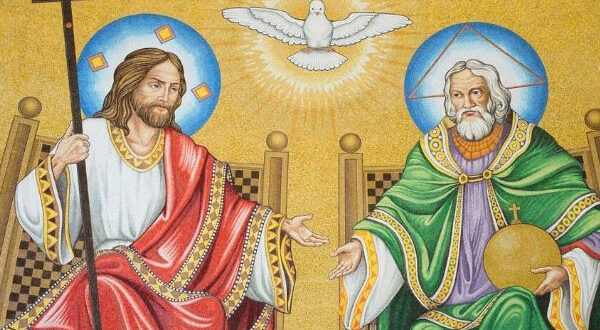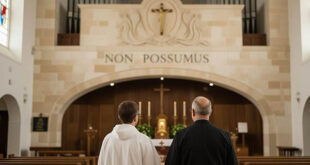One of the deepest and most central mysteries of the Christian faith is the Trinity: one God in three distinct persons—Father, Son, and Holy Spirit—who share a single divine nature. While this concept may seem perplexing at first, it is fundamental to understanding who God is and how He relates to us. The Trinity is not an abstract doctrine intended only for theologians; it is a living truth that directly impacts our faith, our prayers, and our daily lives. In this article, we will explore the origin, meaning, and practical relevance of the mystery of the Holy Trinity, unpacking how this teaching invites us to deepen our relationship with God.
The Origin of the Trinitarian Mystery: Biblical and Historical Roots
The idea of one God in three persons is not a human construction, but a progressive revelation throughout the history of salvation, rooted in Sacred Scripture and developed by the theological reflection of the Church. Although the word “Trinity” does not explicitly appear in the Bible, the foundations of this doctrine are present from the Old Testament to the New Testament.
In the Old Testament, the oneness of God is a central theme: “Hear, O Israel: The Lord is our God, the Lord is one” (Deuteronomy 6:4). This emphasis on God’s unity was key to distinguishing the God of Israel from the many gods of pagan nations. However, even here, we find hints of plurality within the divine nature. For example, in the creation account, God says, “Let us make mankind in our image” (Genesis 1:26), suggesting a conversation within the divinity itself.
It is in the New Testament where the Trinity is more clearly revealed. The most revealing moment occurs at Jesus’ baptism, where the Father speaks from heaven, the Son is baptized in the water, and the Holy Spirit descends in the form of a dove (Matthew 3:16-17). Here, we see the three persons of the Trinity acting in harmony, yet distinct in their roles.
Over the centuries, the Church Fathers, such as St. Athanasius and St. Augustine, worked to clarify this teaching, especially at the Councils of Nicaea (325 AD) and Constantinople (381 AD). These councils affirmed that the Father, the Son, and the Holy Spirit are consubstantial, meaning they share the same divine nature, but are distinct in their internal relationships.
The Trinity in the Life of Faith: Father, Son, and Holy Spirit
One of the most beautiful aspects of the Trinity is how it reveals the relational character of God. Through the Trinity, we learn that God is not a solitary, distant being, but a perfect community of love.
- God the Father: He is the source of all life, the Creator of all that is visible and invisible. Through the Father, we discover the paternal love of God, who has created us in His image and likeness. The Father is, in His essence, love; and this love leads Him to send His Son to save us.
- God the Son: Jesus Christ, the incarnate Word, is the visible revelation of the Father. “Whoever has seen me has seen the Father” (John 14:9). Jesus shows us who God is in His humanity, offering us an example of how to live in love and obedience to God. His sacrifice on the cross is the supreme act of love and redemption, and through His resurrection, He opens the doors of eternal life for us.
- God the Holy Spirit: The Holy Spirit is God’s gift to the Church, guiding, comforting, and strengthening us. It is the Spirit who works sanctification within us and inspires us to live according to God’s commandments. In every sacrament, the Holy Spirit is present, transforming us from within.
Why Is the Trinity Relevant Today?
In our contemporary world, the doctrine of the Trinity holds profound relevance. It reminds us that love and relationship are at the center of the Christian life. The Trinity teaches us that God is communion, and we, created in the image of God, are called to live in communion with one another.
1. The Trinity as a Model of Unity and Diversity
We live in a society marked by divisions—racial, political, economic, and more. The Trinity offers us a model of how diversity can exist within unity. The Father, the Son, and the Holy Spirit are distinct persons, yet they are perfectly united in one God. In the same way, we are called to respect the differences among people and cultures while working together for unity and peace.
2. The Trinity and Community
God is a community of love, and this is reflected in our life as a Church. We cannot be Christians in isolation; we are called to live in community, supporting one another and sharing the love we have received from God. Human relationships—family, friends, the community of faith—are a reflection of Trinitarian love, and when we live these relationships authentically, we participate in the mystery of divine life.
3. The Trinity in Our Prayer
Christian prayer is Trinitarian in structure. We pray to the Father, through the Son, in the Holy Spirit. When we pray, we are not addressing a distant God, but a God who is a loving Father, a redeeming Brother, and a Spirit dwelling within us. By invoking the Trinity in our daily prayers, we enter into the heart of the divine relationship.
Practical Applications of the Trinitarian Mystery in Daily Life
How can we apply the mystery of the Trinity to our daily lives? Here are some concrete ways:
1. Live in Love
God is love, and living according to Trinitarian love means always seeking the good of others. In our relationships, we are called to reflect the generous and sacrificial love we see in the Trinity. This means being patient, merciful, and committed to the well-being of others.
2. Seek Unity in Diversity
In a polarized world, Christians are called to be bridges of reconciliation. The Trinity teaches us that diversity is not a threat, but a blessing. We must learn to value the differences of others and work together for the common good.
3. Pray with a Trinitarian Heart
A concrete way to integrate the Trinity into our lives is through conscious prayer. When we pray, let us make an effort to invoke the three divine persons: the Father who created us, the Son who saved us, and the Holy Spirit who guides us.
Conclusion: The Mystery That Embraces Us
The mystery of the Trinity may seem difficult to fully grasp, but it is not meant to be an unsolvable puzzle. Rather, it is an invitation to enter into a deeper relationship with God, who, in His Trinitarian nature, shows us how to live in love, community, and unity. As we contemplate and live the Trinitarian mystery, we discover that it is not merely an abstract doctrine, but a truth that transforms our lives and draws us closer to the heart of God.
The next time you pray, participate in the Mass, or simply reflect on your faith, remember that you are participating in the mystery of the Trinity. A mystery that is not only at the center of our faith but also the source of all love and life that surrounds us.






